MERCEDES-BENZ CLK COUPE 2004 Workshop Manual
Manufacturer: MERCEDES-BENZ, Model Year: 2004, Model line: CLK COUPE, Model: MERCEDES-BENZ CLK COUPE 2004Pages: 453, PDF Size: 14.93 MB
Page 51 of 453
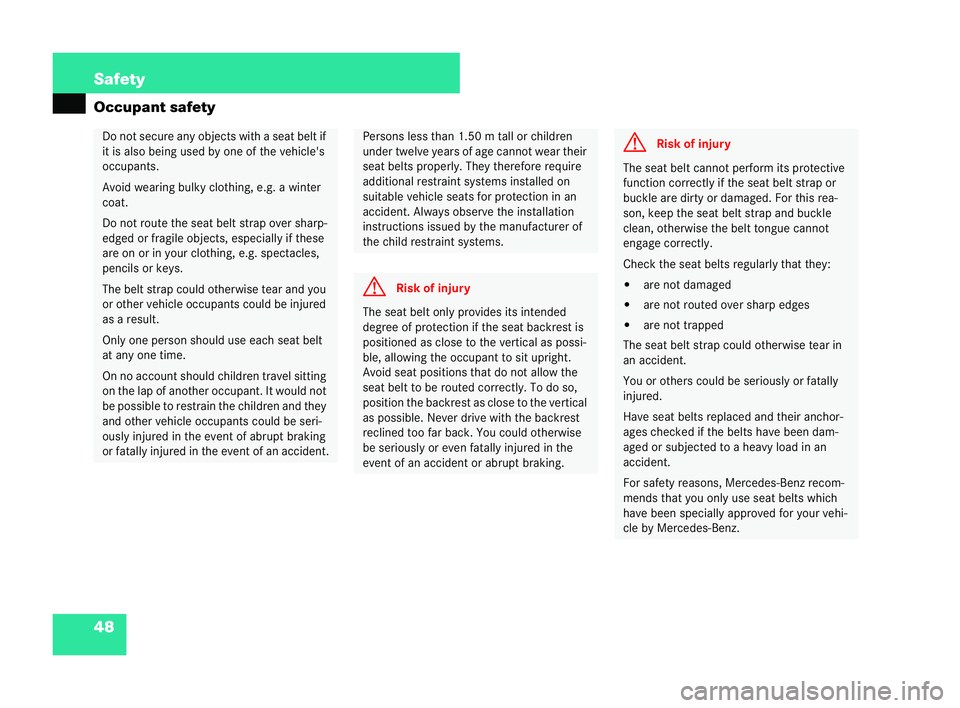
48 Safety
Occupant safety Do not se
cure any object s with a seat belt if
it is also being used by one of the vehi cle's
occupa nts.
Avoid wearing bulky clothing, e.g. a winter
coat.
Do not rout ethe seat belt strap over sharp-
edged or fragile objects, especially if these
ar e on orinyour cl othing, e.g. spectac les,
pencils or keys.
The belt strap could otherwise tear and you
or other vehicl eoccupa nts could be injured
as aresult.
Onl yone person should use each seat belt
at anyo ne time.
On no account should chil dren travel sitting
on the lap of anotheroccupa nt. It wou ldnot
be possible to restrain the children and they
and other vehicle occupan tscou ldbe seri-
ously injured in the event of abrupt braking
or fatally injured in th eevent of an accident. Persons less than 1.50 m
tall or children
un der twelve years of agecannot wear their
seat belts properly. The yth ere fore require
additio nal restraint systems installed on
suitable vehicle seats for protection in an
accident. Always observe the installation
instructions issued by the manufactu rer of
the child re straint systems. G
Risk of injury The seat belt onl
yprovides its intended
degree of protection if the seat bac krest is
positioned as close to the vertical as possi-
ble, allowing the occupant to sit upright.
Avoid seat positions that do not allow the
seat belt to be routed correctly. To do so,
position the backrest as close to th evertical
as possible. Never drive with the backrest
recli ned too far back. You could otherwise
be serio uslyor even fatally injured in the
event of an accident or abrupt bra king. G
Risk ofinjury The seat belt cannot perform its protective
function
correctly if the seat belt strap or
buckle are dirty or damaged. For this rea-
son, keep the seat belt strap and buckle
clean, otherwise the belt tongu eca nnot
engage correctly.
Chec kthe seat belts regularly that they:
�! arenot damag ed
�! are not routed over sharp edges
�! are not trapped
The seat belt strap could oth erwi se tear in
an accident.
Yo u or ot hers could be seriously or fatally
injured.
Have seat belts replaced and their anchor-
ages checked if the belts have been dam-
age dors ubjected to a heavyloa din an
accid ent.
For safety reasons, Mercedes-Benz recom-
mends that you only use seat belts which
have been specially approved for your vehi-
cl e by Mercedes-Be nz.209en_d2.boo Seite
48Diens tag, 25 .Mai 2004 7:26 19
Page 52 of 453
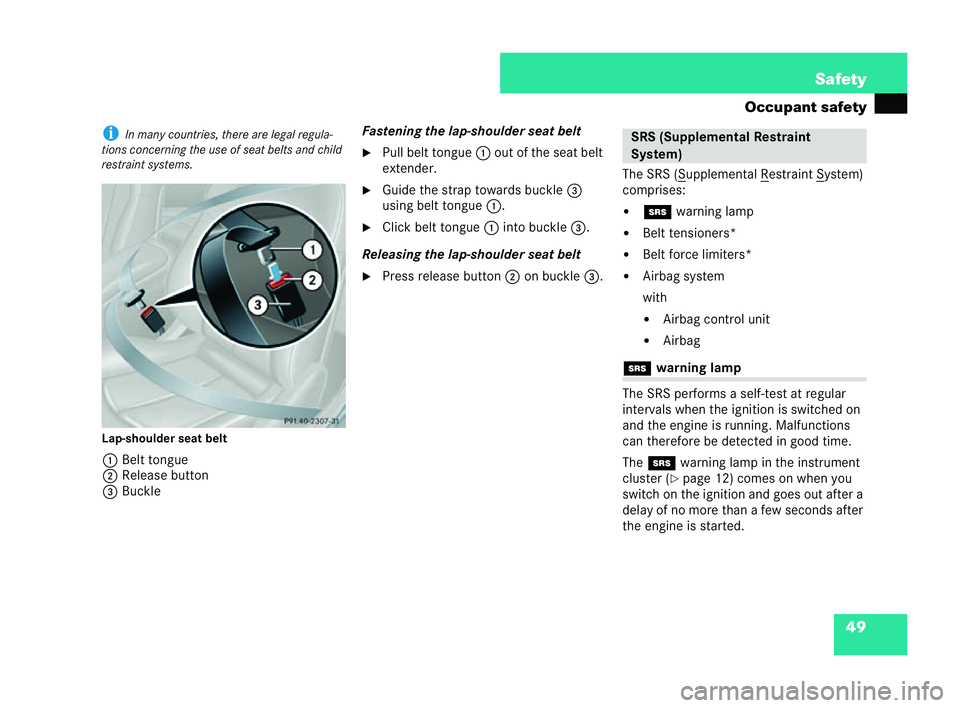
49
Safety
Occupant safety i
Inma nycountries, there are legal regula-
tions concerning th euse of seat belts and child
restraint sys tems.
Lap-shoulder seat belt 1 Belt tongue
2 Release button
3 Buc kle Fastening the lap-shoulder seat belt
�6 Pull bel ttongue 1out of the seat belt
extender.
�6 Guide the strap towards buckle 3
using belt tongue 1.
�6 Click belt tongue 1into buckle 3.
Rel easing the lap-shoulder seat belt
�6 Press release button 2on buck le3 . The
SRS (S upplemental R estraint S ystem)
comprises:
�! 1 warning lamp
�! Belt tensioners*
�! Belt force limiters*
�! Airbag system
with
�! Airbag control unit
�! Airbag 1
warning lamp
The SRS performs a sel f-test at regular
intervals when the ignition is switched on
and the engine is runn ing. Malfunctions
can therefore be detected in good time.
The 1 warning lamp in the instrume nt
cluster ( �=page 12) comes on when you
switch onthe ignition and goes out after a
delay of no more than a few seconds after
the engine is started.
P91.40-2307-31 SRS (Supplemental Restraint
System)209en_d2.boo Seite
49Diens tag, 25 .Mai 2004 7:26 19
Page 53 of 453
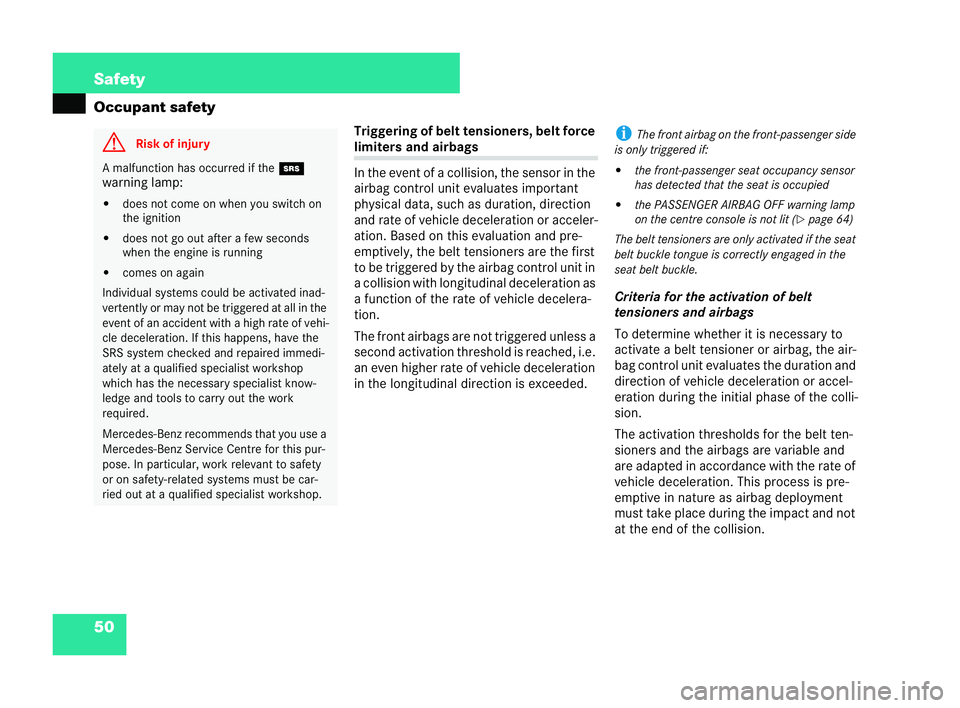
50 Safety
Occupant safety
Triggering ofbelt tensioners, belt force limiters and
airbags
In the event ofa collision, the sensor in the
airbag contro lunit evaluates important
physical data, such as duration, direction
and rate of veh icle deceleration or acceler-
ation. Based on this evaluation and pre-
emptively, the belt tensioners are the first
to be triggered by the airb agcontrol unit in
a collis ion with longi tudinal deceleration as
a function of the rate of vehicle decelera-
tion.
The front airbags are not triggered unless a
second activation threshold is reached, i.e.
an even higher rate of vehicle deceleration
in the longitudinal direction is exceeded. i
Thefront airbag on the front-passenger side
is only tri ggered if:
�! the front-passenger seat oc cupancy sensor
has detected that the seat is occupied
�! the PASSENGER AIRBAG OFF warning lamp
onthe centre console is not lit (
�=page 64)
The belt tensioners are only activated if the seat
belt buck le tongue is correctl yengaged in the
se at belt buckle.
Criteria for the activation of belt
tensioners and airbags
To determine whether it is necessary to
activ ate a belt tensioner or airbag, the air-
bag control unit evaluates the duration and
direction of vehicle deceleration or accel-
eration during the initial phase of the colli-
sion.
The activation thresholds for the belt ten-
sioners and the airbags are variable and
are adapted in accordance with the rate of
ve hicle deceleration. This process ispre-
emptive in nature as airbag deployment
must take place during the impact and not
at the end of the collision. G
Risk of inju ry A malfu
nction has occurred if the 1
warning lamp:
�! doesnot com eon when yousw itchon
th eignition
�! does not go out after a few seconds
when the engine is running
�! comes on again
Individ ual systems could beactivated inad-
verte ntly or may not be triggered at all in the
event of an accident with a high rate of vehi-
cle deceleration. Ifthis happens, have the
SRS system checked and repaired immedi-
ately at a qualified specialist wor kshop
wh ich has the necessary specialist know-
ledg eand tools to carry out the work
require d.
Mercedes-Benz recomme nds that youuse a
Mercedes-Benz Service Centre for this pur-
pose. In particular, work relevant to safety
or on safety-re lated systems must be car-
ried out at a qualified specialist workshop. 209en_d2.boo Seite
50Diens tag, 25 .Mai 2004 7:26 19
Page 54 of 453
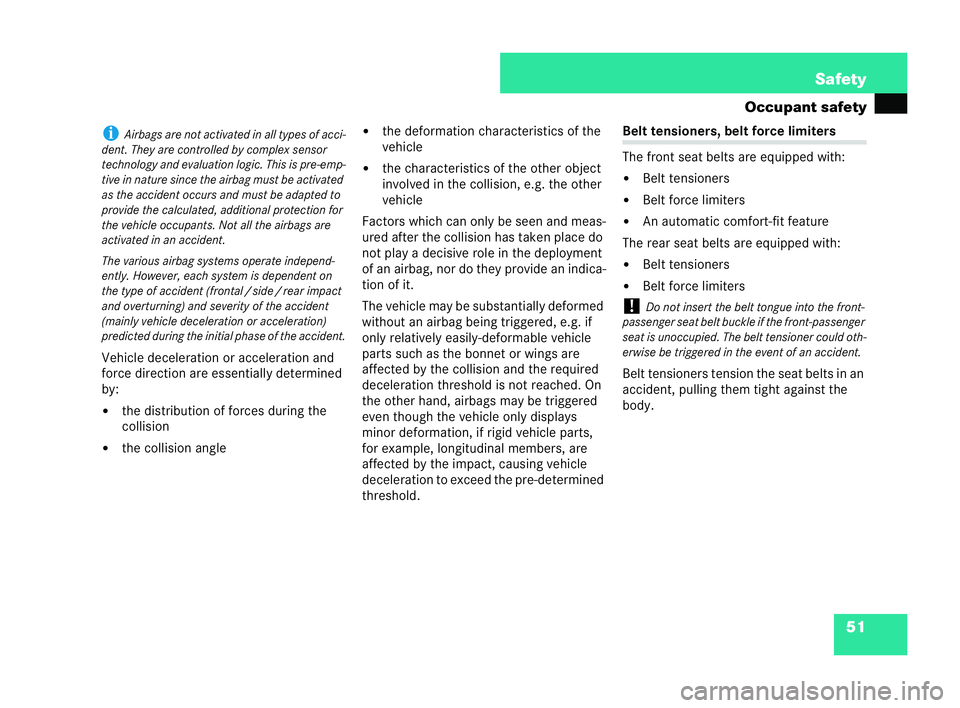
51
Safety
Occupant safety i
Airbags ar enot activat edin all types of acci-
dent .The yare controlled by complex sensor
technology and evaluation logic .This ispre-emp-
tiv einnature since theairbag must beactivat ed
as the accident occurs and must be adap ted to
provide the cal culated, additional protection for
the vehicle occupants. Not all the airbags are
act ivated in an accident.
The various airbag sy stems operate independ-
ently .However, each sy stem is dependent on
the type of accident (frontal /side /rear impact
and overturning) and severity of th eaccident
(mainly vehicle deceleration or acc eler ation)
predicted during the initial phase of the accident.
Vehicle deceleration or acceleration and
force direction are essentially determined
by:
�! the distribution of forces during the
collision
�! the collision angle �!
the deformation characteristics of the
vehicle
�! the characteristi csofthe other object
in volved in the collision, e.g. the other
ve hicle
Factors which can only be seen and meas-
ured after the collision has taken place do
not play a dec isive role in the deployment
of an airbag, nor do they provide an indica-
tion of it.
The vehicle may be substantia lly deformed
wi thout an airbag being triggered, e.g. if
only relatively easi ly-deformable vehicle
parts such as the bonnet or wings are
affected by the collision and the required
deceleration threshold isnot reached. On
the other hand, airbags may be triggered
even though the vehicle only displays
minor deformation, if rigid vehicle parts,
for example, longitud inal membe rs, are
af fe cted by theimpact, causing vehicle
deceleration to exceed the pre-determined
threshold. Belt tensioners, belt force limiters
The front seat belts are equipped with:
�!
Belt tensioners
�! Belt force limiters
�! An autom atic comf ort-fit feature
The rear seat belts are equipped with: �! Belt tensioners
�! Belt force limiters
! Do not insert the belt tongue into the front-
passenger seat belt buckle if the front-passenger
seat is unocc upied. The belt tensioner could oth-
erw ise be trigg ered in theevent ofan accident.
Be lttensioners tension the seat belts inan
accident, pull ing them tight against the
bod y. 209en_d2.boo Seite
51Diens tag, 25 .Mai 2004 7:26 19
Page 55 of 453
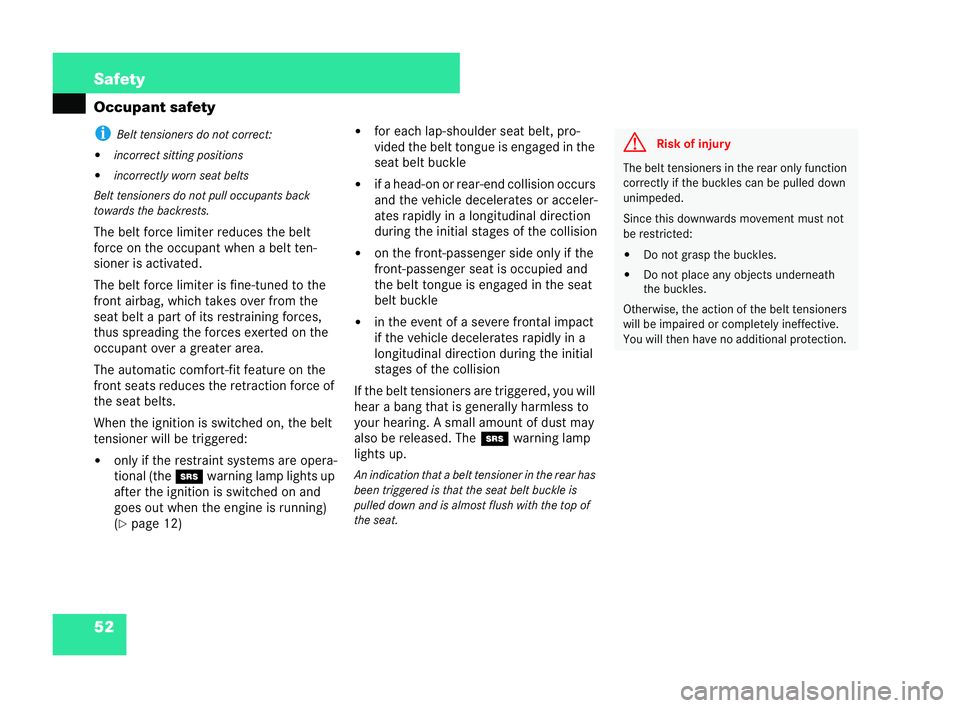
52 Safety
Occupant safetyi
Belt tensioners do not correct:
�! inco rrect sitting positions
�! incorrectly worn seat belts
Belt tensioners do not pull occ upants back
towar dsthe backrests.
The belt force limiter reduces the belt
force on the occupant when a belt ten-
sioner is activated.
The belt force limiter is fine-tuned to the
front airbag, which takes over from the
seat belt a part of its restraining forces,
thus spreading the forces exerted on the
occupant over a greater area.
The automatic comfort-fit feature on the
front seats reduces the retraction force of
the seat belts.
When the igniti onisswit ched on, the belt
tensioner will be triggered:
�! only if the res traint systems are opera-
tional (the 1warning lamp lights up
after the ignition is switched on and
goes out when the engine is running)
( �= page 12) �!
forea ch lap- shou lder sea tbe lt, pro-
vided the belt tongue is engaged inthe
seat belt buckle
�! if a head-on or rear-end col lision occurs
and the veh icle decelerates or acceler-
ates rapidly ina longitudinal direction
during the initial stages ofthe collision
�! on the front-passenger side only ifthe
front-passenger seat is occupied and
the belt tongue is engaged in the seat
belt buckle
�! in the event of a severe fronta limpact
if the vehicle decelerates rapidly in a
longitudinal direction during the ini tial
stages of the collision
If the be lttensioners are tri ggered, you will
hear a bang that is genera lly harmless to
your hearing. A small amount of dust may
also be released. The 1warning lamp
lights up.
An indication that a belt tensioner in there ar has
been trigger edisthat the seat belt buckle is
pu lled down and is almost flush with the topof
the seat. G
Risk ofinjury The
belt tensioners in the rear only function
correctly ifthe buckl escan be pulled down
unimpeded.
Since this downwards movementmust not
be restricted:
�! Do not grasp the buckles.
�! Do not pl ace any obj ects un derneath
the buckles.
Ot he rwi se, the action of the belt tensioners
will beimpaired or completely ineffective.
You will then have no additional prot ection. 209en_d2.boo Seite
52Diens tag, 25 .Mai 2004 7:26 19
Page 56 of 453
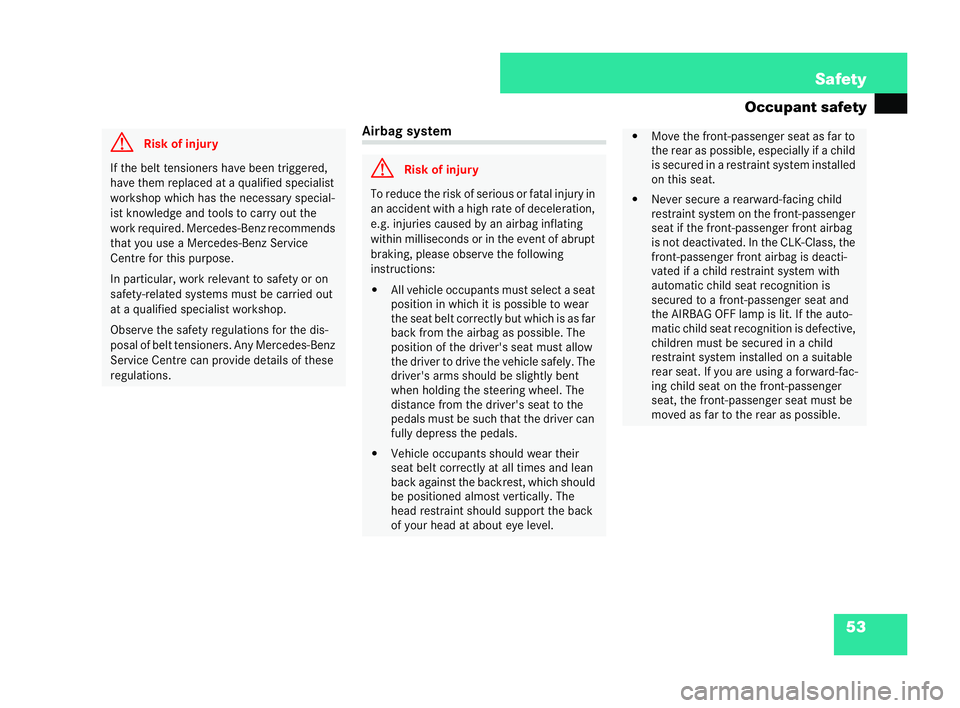
53
Safety
Occupant safety Ai
rb ag syst em G
Risk ofinjury If the belt tensi
onersha ve bee ntriggered,
have them replaced ata qualified specialist
workshop which has th eneces sary special-
ist knowledge and tools to carry out the
work required. Mercedes -Benz recommends
that you use a Mercedes-Be nzService
Centre for this purpose.
In particular, work rele vant to safety or on
safe ty-re lated systems mustbe carried out
at a qualified spec ialist workshop.
Ob serve the safety regulations for th edis-
posal of belt tensioners. Any Mercedes-B enz
Service Centre can provide detail sof these
regulations. G
Risk of injury To reduce the risk of serious or fata
linjury in
an accident with a high rate of deceleration,
e.g. injuries caused by an airbaginflating
within milliseconds or in the ev ent of abrupt
br aking, please observe the following
inst ructions:
�! Allve hicle occupants must select a seat
position in which it is possible to wear
the seat belt correctl ybut which is as far
back from the airba gas possible. The
position of the driver's seat must allow
the driver to drive th evehicle safely. The
driver's arms shou ldbe slightly bent
when holding the steering wheel. The
distance from th edriver's seat to the
pedals must be such that the dr iver can
fully depress the pedals.
�! Vehicle occupants should wear their
seat belt correctly at all times and lean
back against the bac krest, which should
be positioned almost vertically. The
head restraint should support the back
of yo urhead at abo uteye level. �!
Move the front- passenger seat as far to
the rear as possible, especially if a child
is secured in a restraint system installed
on this sea t.
�! Never secure a rearward-facing child
restraint system on the front-pass enger
seat if the front-passenger front airbag
is not deactivate d.In the CLK-Class, the
fr ont-passen ger fro ntairbag is deacti-
vated if a child restraint system with
automatic child seat recognition is
secured to a front-passenger seat and
the AIRBAG OFF lamp is lit. If the auto-
matic child seat rec ognition is defective,
children must be secured in a child
restraint system ins talled on a suitable
re ar seat. If you are using aforward-f ac-
in g child seat on the fro nt-pa ssen ger
seat, the front-passenger seat must be
moved as far to the rear as possibl e. 209en_d2.boo Seite
53Diens tag, 25 .Mai 2004 7:26 19
Page 57 of 453
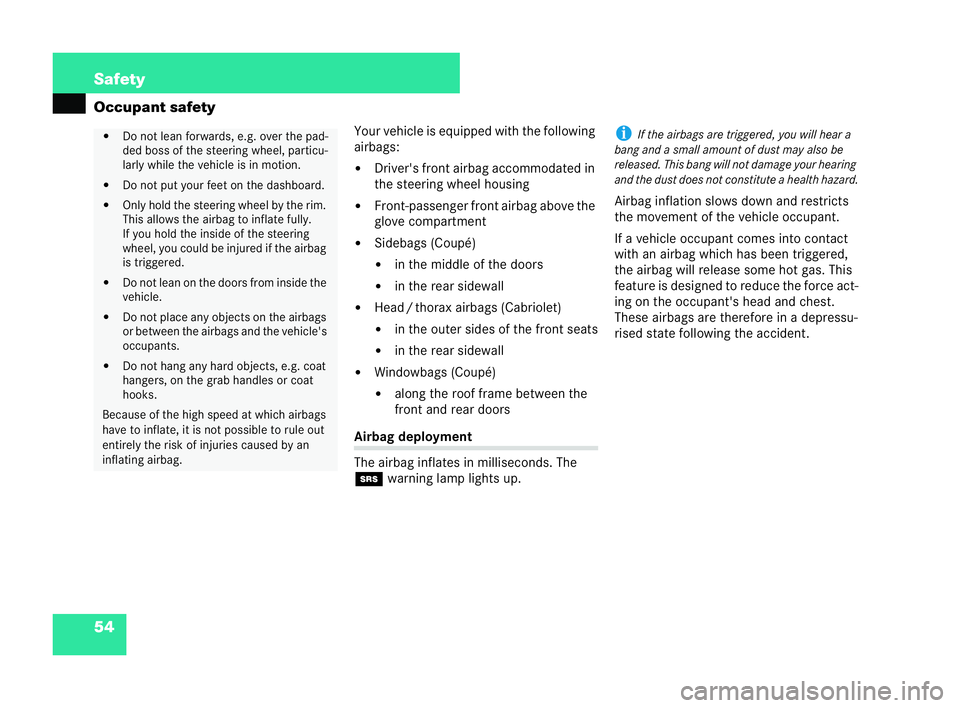
54 Safety
Occupant safety
Your vehicleisequipped with the follo wing
airbags:
�! Driver's front airbag accommodated in
the steering wheel housing
�! Front-passenger fron tairbag above the
glove compartment
�! Sidebags (Coupé)
�! in the middle of the doors
�! in the rear sidewall
�! Head /thorax airba gs(Cabriolet)
�! in the outer sides of the front seats
�! in the rear sidewall
�! Windowbags (Coupé)
�!along the roof frame betw een the
front and rear doors Airbag
deploym ent
The airbag inflates in milliseconds. The
1 warning lamp lights up. i
Ifth e airba gsare triggered, you will hear a
bang and asmall amount ofdust may also be
released. This bang will not damage your hearing
and the dust does not constitu te ahealth hazard.
Airbag inflation slows down and restricts
the mo vement of the vehicle occupant.
If a vehicle occupant comes into contact
with an airbag which has been triggered,
the airbag will release some hot gas. This
feature is designed to reduce the force act-
ing on the occupant's head and ch est.
These airbags are theref orein a depress u-
rised state follo wing the accident. �!
Do not lean forwards , e.g. over the pad-
ded boss of the steering wheel, particu-
la rly while the vehicle is in motion.
�! Do not put your feet on the dashboard.
�! Only hold the steering wheel by the rim.
This allows the airbag to inflate fully.
If you hold the ins ideo f the steering
wheel, you could be injured if the airbag
is triggered.
�! Do not lean on the doo rsfrom inside the
vehicle.
�! Donot place any objects onthe airba gs
or between the airbags and the vehicle's
oc cupants.
�! Donot ha nganyha rd obje cts, e.g. coat
hangers ,on the grab handles or coat
hook s.
Because of the high speed at which airbags
have to inflate, it is not possib leto rule out
entire lythe risk of injurie scaused by an
inflating airbag. 209en_d2.boo Seite
54Diens tag, 25 .Mai 2004 7:26 19
Page 58 of 453
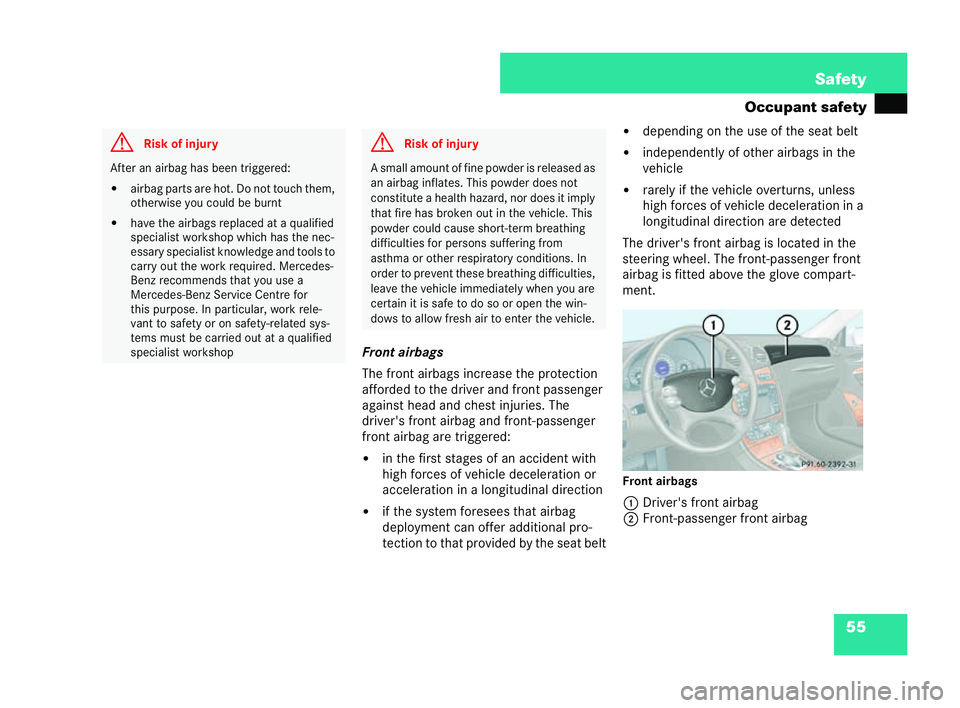
55
Safety
Occupant safety
Front airbags
The front airbags increase the protection
afforded to the driver and front passenger
against head and chest in juries. The
driver's front airbag and front-passenger
front airbag are triggered:
�! inthe first stages of an accident with
high forces of vehicle deceleration or
acceleration in a longi tudinal direction
�! ifthe system foresees that airbag
deployment can offer additional pro-
tection to that provided by the seat belt �!
depending on the use of the seat belt
�! independently of other airbags in the
vehicle
�! rarely if the vehicle overturns, unless
high forces of vehicle deceleration in a
long itudinal direction are detected
The dri ver's front airbag is located inthe
steering wheel. The front-passenge rfront
airbag is fitted above the glove compart-
ment.
Front airbags
1 Driver's front airbag
2 Front-passenger front airbag G
Risk ofinjury Af
ter an airbag has bee ntriggered:
�! airbag parts are hot. Do not touch them,
oth erwi se you could be burnt
�! have the airbags replaced at a qualified
specialist workshop whic hhas the nec-
essary specialist knowledge and tools to
carry out the work required. Mercedes-
Ben zrecom mends that you use a
Mercedes -Benz Serv ice Centre for
this purpose. Inparticular, work rele-
vant to safety or on safety-relate dsys-
tems must be carried out at a qualified
specialist workshop G
Risk of injury A small
amount of finepowder is released as
an airbag inflates. Thi spowder does not
constitute a health hazard, nor does it imply
that fire has brok enout in the vehicle. This
po wder could cause short-term breathing
dif ficu lties for persons suffering from
as thma or oth errespiratory conditions. In
order to prev ent these breathing difficulties,
leave the vehicle immediately when you are
certain it is safe to do so or open the win-
do ws to allow fresh air to enter the ve hicle.
P91.60-2392-31 209en_d2.boo Seite
55Diens tag, 25 .Mai 2004 7:26 19
Page 59 of 453
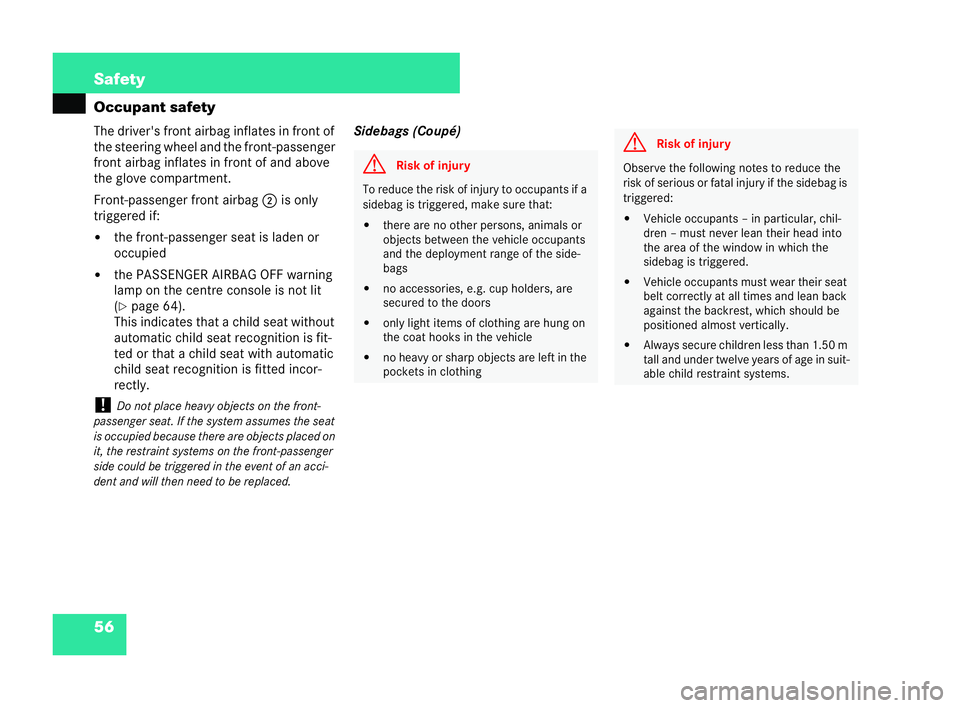
56 Safety
Occupant safety
The driver's front airbag
inflates in front of
the steering wheel and the front-passen ger
front airbag inflates infront of and above
the glove compartment.
Front-passenger front airbag 2ison ly
triggered if:
�! the front-passenger seat is laden or
occupied
�! the PASSENGER AIRBAG OFF wa rning
lamp on the centre console is not lit
(�= page 64).
This indicates that a child seat without
au tomatic child seat rec ognition is fit-
te d or that achild seat wit hautomatic
child seat recognition is fitte dincor-
rec tly.
! Do not place heavy objects onthe front-
pas seng er seat. Ifthe system assumes the seat
is occupied because there are objects placed on
it, the restr aint systems on the front-passe nger
si de could be triggered in the event of an acci-
dent and will then need to be replaced. Sidebags (Coupé) G
Risk of injury To reduce the risk of in
juryto occu pantsif a
sidebag is triggered, make sure that:
�! there are no other persons ,animals or
ob jects between the vehic leoccu pants
and the deployment range of the side-
bags
�! noacce ssories, e.g. cup holders, are
secure dto the doors
�! only lig htitems of clothing are hun gon
the coat hooks in the vehicle
�! no heavy or sharp objec tsare lef tin the
pockets in clo thing G
Risk ofinjury Ob
serve the following notes to reduce the
ris ko f serio usorfatal in jury if the sidebag is
triggered:
�! Vehicle occupants – in particular, chil-
dren – must never lean their head into
the area of the window in which the
sidebag is triggered.
�! Vehicle occupants must wear their seat
belt correctly at all times and lean back
against the backrest, which should be
positioned almost vertically.
�! Always secure children less than 1.50 m
tall and under twelve years of age insuit-
able child restraint systems. 209en_d2.boo Seite
56Diens tag, 25 .Mai 2004 7:26 19
Page 60 of 453
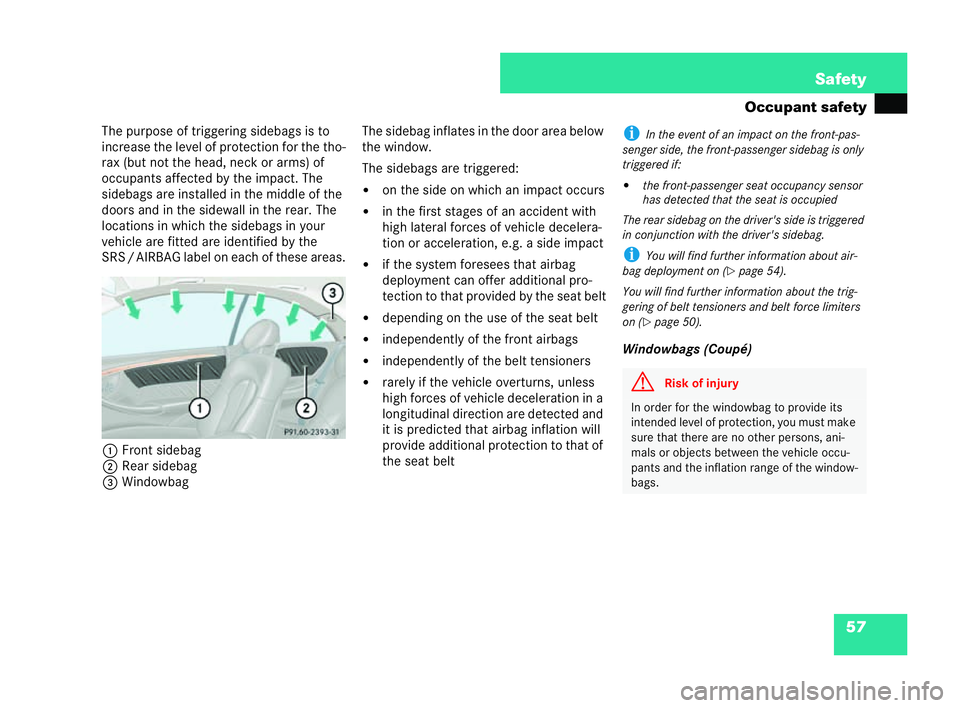
57
Safety
Occupant safety
The purpose of triggering sidebags is to
increase the level of protection for the tho-
rax (but not the head, neck or arms) of
occupants affected by the impact. The
sidebags are installed in the middle of the
doors and in the sidewa llin the rear. The
locations in which the sidebags in your
ve hicle are fitted are identified by the
SRS /AIRBAG label on each of these areas.
1 Front sidebag
2 Rea rsidebag
3 Windowbag The sid
ebag inflates in the door area below
the window.
The sidebags are triggered:
�! on the side on which an impact occurs
�! inthe first stages of an accident with
high lateral forces of vehicle decelera-
tion or acceleration, e.g. a side impact
�! ifthe system foresees that airbag
deployment can offer additional pro-
tection to that provided by the seat belt
�! depending on the use of the seat belt
�! independently of the front airbags
�! independently of the belt tensioners
�! rarely if the vehicle overturns, unless
high forces of vehicle deceleration ina
lo ngitudinal direction are detected and
it is predi cted that airbag inflation will
prov ide additional protection to that of
the seat belt i
Inthe eve ntofan imp act on the front-pas-
senger side, the front-passenger sidebag is only
triggered if:
�! the front -pas se nger seat occupancy sensor
ha s detecte dthat the seat is occ upied
The rear sidebag on the driver's side is triggered
in conjun ction wit hthe driver's sidebag.
i You will find further information about air-
bag depl oyment on ( �=
page 54).
You will find furt herin formation about the trig-
gering of belt tensioners and belt force limiters
on ( �=
page 50).
Win dowbags (Coupé)
P91.40-2393-31 G
Risk of inju ry In ord
erfor the windowbag to provide its
intended level of prot ection, you must make
sure that there are no other persons, ani-
mals or objects between the vehic leoccu-
pants and the inflation range of the window-
bags. 209en_d2.boo Seite
57Diens tag, 25 .Mai 2004 7:26 19